Stability Analysis of a System of Exponential Difference Equations
Abstract
We study the boundedness character and persistence, existence and uniqueness of positive equilibrium, local and global behavior, and rate of convergence of positive solutions of the following system of exponential difference equations: , , where the parameters αi, βi, γi, ai, bi, and ci for i ∈ {1,2} and initial conditions x0, x−1, y0, and y−1 are positive real numbers. Furthermore, by constructing a discrete Lyapunov function, we obtain the global asymptotic stability of the positive equilibrium. Some numerical examples are given to verify our theoretical results.
1. Introduction
Many population models are governed by exponential difference equations. We refer to [1–6] and the references therein. Systems of nonlinear difference equations of higher-order are of paramount importance in applications. Such equations also appear naturally as discrete analogues and as numerical solutions of systems differential and delay differential equations which model diverse phenomena in biology, ecology, physiology, physics, engineering, and economics. For applications and basic theory of rational difference equations we refer to [7–9]. In [10–17] applications of difference equations in mathematical biology are given. It is very interesting to investigate the behavior of solutions of a system of nonlinear difference equations and to discuss the local asymptotic stability of their equilibrium points.
More precisely, we investigate the boundedness character and persistence, existence and uniqueness of positive steady state, local asymptotic stability and global behavior of unique positive equilibrium point, and rate of convergence of positive solutions of system (5) which converge to its unique positive equilibrium point. Some special cases of system (5) can be treated as population models of two species [3].
2. Main Results
The following theorem shows that every solution of (5) is bounded and persists.
Theorem 1. Every positive solution {(xn, yn)} of system (5) is bounded and persists.
Proof. For any positive solution {(xn, yn)} of system (5), one has
Lemma 2. Let {(xn, yn)} be a positive solution of system (5). Then, [L1, U1] × [L2, U2] is invariant set for system (5).
Proof. The proof follows by induction.
2.1. Stability Analysis
Definition 3. Let be an equilibrium point of the system (9).
- (i)
An equilibrium point is said to be stable if for every ɛ > 0 there exists δ > 0 such that for every initial condition (xi, yi), i ∈ {−1,0}, if implies for all n > 0, where ∥·∥ is usual Euclidian norm in .
- (ii)
An equilibrium point is said to be unstable if it is not stable.
- (iii)
An equilibrium point is said to be asymptotically stable if there exists η > 0 such that and as n → ∞.
- (iv)
An equilibrium point is called global attractor if as n → ∞.
- (v)
An equilibrium point is called asymptotic global attractor if it is a global attractor and stable.
Definition 4. Let be an equilibrium point of a map F = (f, xn, g, yn), where f and g are continuously differentiable functions at . The linearized system of (9) about the equilibrium point is
Lemma 5 (see [9].)Assume that Xn+1 = F(Xn), n = 0,1, …, is a system of difference equations such that is a fixed point of F. If all eigenvalues of the Jacobian matrix JF about lie inside the open unit disk |λ | < 1, then is locally asymptotically stable. If one of them has a modulus greater than one, then is unstable.
Theorem 6. System (5) has a unique positive equilibrium point , if the following condition is satisfied:
Proof. Consider the following system of equations:
Theorem 7. The unique positive equilibrium point of system (5) is locally asymptotically stable under the following condition:
Proof. The characteristic polynomial of Jacobian matrix about is given by
Theorem 8. The unique positive equilibrium point of system (5) is globally asymptotically stable, if the following condition is satisfied:
Proof. Arguing as in [18], we consider the following discrete time analogue of Lyapunov function:
2.2. Rate of Convergence
In this section we will determine the rate of convergence of a solution that converges to the unique positive equilibrium point of the system (5).
Proposition 9 ((Perron’s Theorem) [19]). Suppose that condition (40) holds. If Xn is a solution of (39), then either Xn = 0 for all large n or
Proposition 10 (see [19].)Suppose that condition (40) holds. If Xn is a solution of (39), then either Xn = 0 for all large n or
Using Proposition 9, one has the following result.
2.3. Examples
In order to verify our theoretical results and to support our theoretical discussions, we consider several interesting numerical examples in this section. These examples represent different types of qualitative behavior of solutions to the system of nonlinear difference equations (5). The first and last examples show that positive equilibrium of system (5) is unstable with suitable parametric choices. Moreover, from the remaining examples it is clear that unique positive equilibrium point of system (5) is globally asymptotically stable with different parametric values.
Example 1. Let α1 = 6.5, β1 = 8.5, γ1 = 12.3, a1 = 1.6, b1 = 5.02, c1 = 1.2, α2 = 3.5, β2 = 5.5, γ2 = 1.3, a2 = 0.1, b2 = 0.003, and c2 = 2.2. Then, system (5) can be written as
In this case the positive equilibrium point of the system (50) is unstable. Moreover, in Figure 1 the plot of xn is shown in Figure 1(a), the plot of yn is shown in Figure 1(b), and a phase portrait of the system (50) is shown in Figure 1(c).
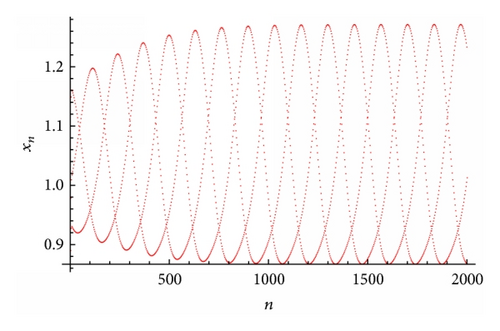
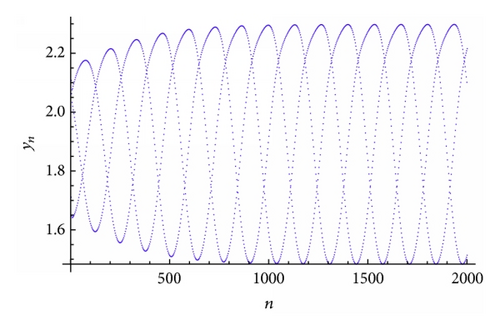
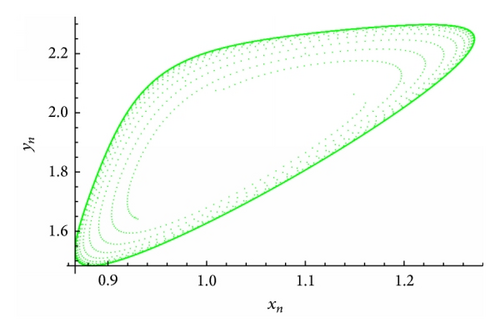
Example 2. Let α1 = 1.5, β1 = 7.5, γ1 = 13.5, a1 = 2.1, b1 = 7.92, c1 = 0.95, α2 = 4.1, β2 = 7.2, γ2 = 16.7, a2 = 0.01, b2 = 0.2, and c2 = 2.3. Then, system (5) can be written as
In this case the unique positive equilibrium point of the system (51) is given by . Moreover, in Figure 2 the plot of xn is shown in Figure 2(a), the plot of yn is shown in Figure 2(b), and an attractor of the system (51) is shown in Figure 2(c).
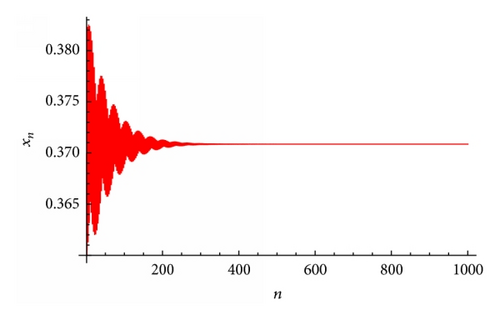
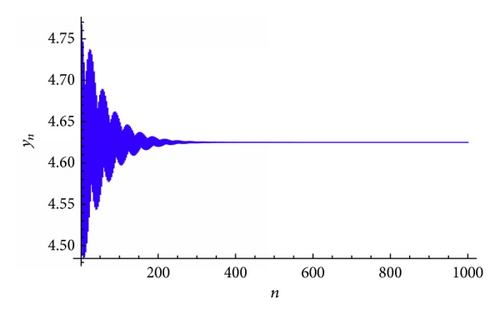
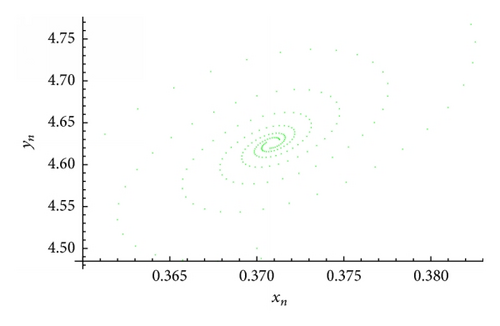
Example 3. Let α1 = 8.98, β1 = 75, γ1 = 135, a1 = 21, b1 = 79, c1 = 5, α2 = 41, β2 = 71.9, γ2 = 16, a2 = 6, b2 = 2, and c2 = 30. Then, system (5) can be written as
In this case the unique positive equilibrium point of the system (52) is given by . Moreover, in Figure 3 the plot of xn is shown in Figure 3(a), the plot of yn is shown in Figure 3(b), and an attractor of the system (52) is shown in Figure 3(c).
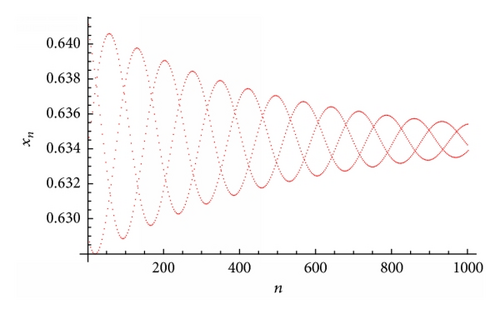
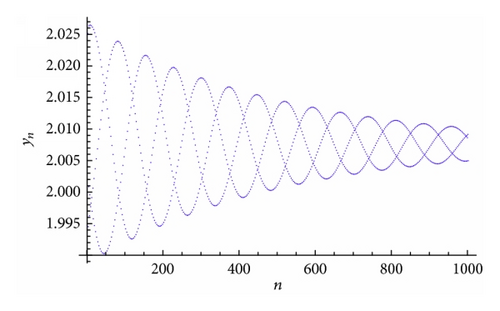
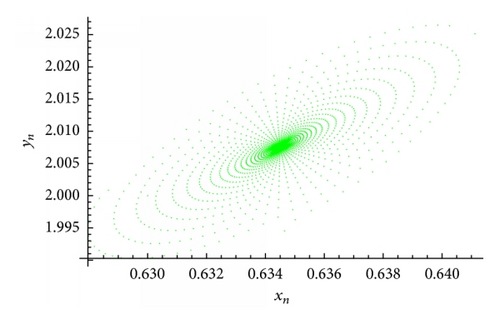
Example 4. Let α1 = 23.8, β1 = 350, γ1 = 66, a1 = 55, b1 = 14, c1 = 111, α2 = 66, β2 = 35, γ2 = 87, a2 = 1.7, b2 = 80, and c2 = 1.4. Then, system (5) can be written as
In this case the unique positive equilibrium point of the system (53) is given by . Moreover, in Figure 4 the plot of xn is shown in Figure 4(a), the plot of yn is shown in Figure 4(b), and an attractor of system (53) is shown in Figure 4(c).
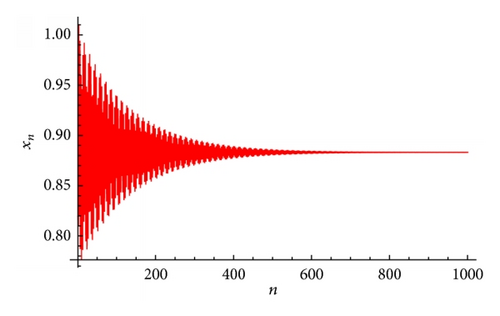
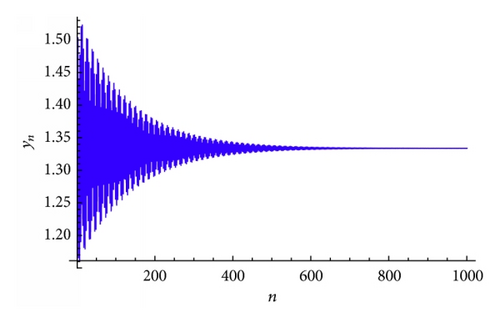
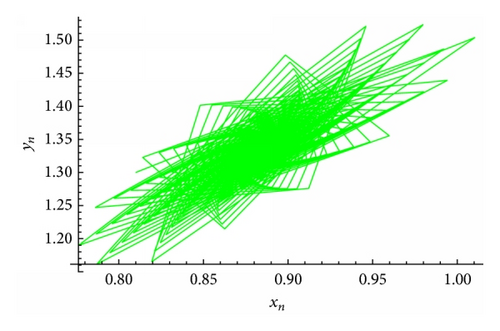
Example 5. Let α1 = 8, β1 = 3, γ1 = 6, a1 = 0.05, b1 = 4, c1 = 16, α2 = 9, β2 = 17, γ2 = 7, a2 = 0.07, b2 = 22, and c2 = 0.2. Then, system (5) can be written as
In this case the positive equilibrium point of the system (54) is unstable. Moreover, in Figure 5 the plot of xn is shown in Figure 5(a), the plot of yn is shown in Figure 5(b), and a phase portrait of system (54) is shown in Figure 5(c).
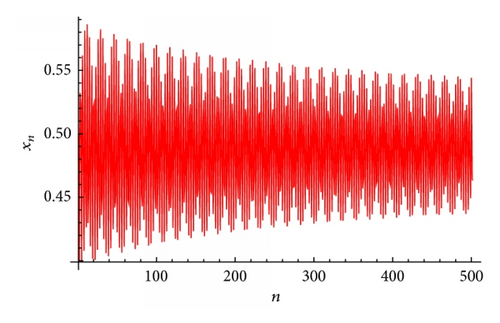
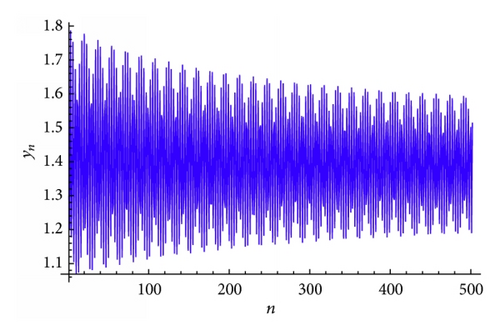
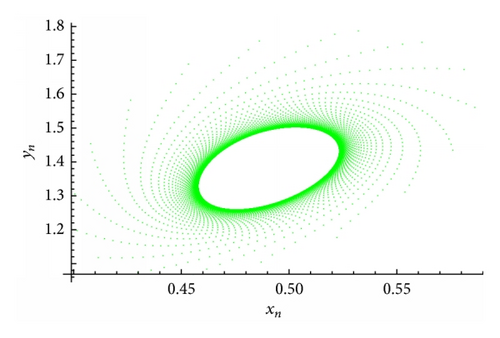
3. Concluding Remarks
In literature several articles are related to qualitative behavior of exponential systems of rational difference equations. It is a very interesting mathematical problem to study the dynamics of such systems because these are closely related to models in population dynamics and biological sciences. This work is related to qualitative behavior of an exponential system of second-order rational difference equations. We have investigated the existence and uniqueness of positive steady state of system (5). Under certain parametric conditions the boundedness and persistence of positive solutions are proved. Moreover, we have shown that unique positive equilibrium point of system (5) is locally as well as globally asymptotically stable. The main objective of dynamical systems theory is to predict the global behavior of a system based on the knowledge of its present state. An approach to this problem consists of determining the possible global behaviors of the system and determining which parametric conditions lead to these long-term behaviors. By constructing a discrete Lyapunov function, we have obtained the global asymptotic stability of the positive equilibrium of (5). Furthermore, rate of convergence of positive solutions of (5) which converge to its unique positive equilibrium point is demonstrated. Finally, some illustrative examples are provided to support our theoretical discussion.
Conflict of Interests
The authors declare that they have no conflict of interests regarding the publication of this paper.
Acknowledgments
The authors thank the main editor and the anonymous referees for their valuable comments and suggestions leading to improvement of this paper. This work was supported by the Higher Education Commission of Pakistan.




